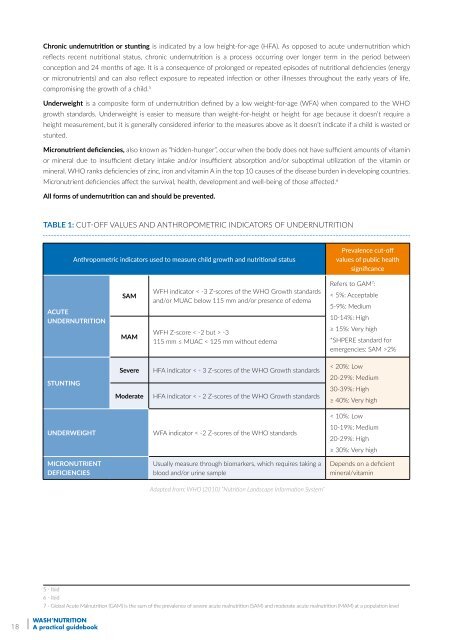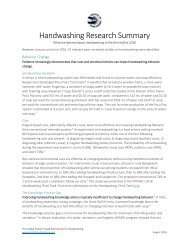WASH’ Nutrition
manuel_wash_nutrition_online
manuel_wash_nutrition_online
Create successful ePaper yourself
Turn your PDF publications into a flip-book with our unique Google optimized e-Paper software.
Chronic undernutrition or stunting is indicated by a low height-for-age (HFA). As opposed to acute undernutrition which<br />
reflects recent nutritional status, chronic undernutrition is a process occurring over longer term in the period between<br />
conception and 24 months of age. It is a consequence of prolonged or repeated episodes of nutritional deficiencies (energy<br />
or micronutrients) and can also reflect exposure to repeated infection or other illnesses throughout the early years of life,<br />
compromising the growth of a child. 5<br />
Underweight is a composite form of undernutrition defined by a low weight-for-age (WFA) when compared to the WHO<br />
growth standards. Underweight is easier to measure than weight-for-height or height for age because it doesn’t require a<br />
height measurement, but it is generally considered inferior to the measures above as it doesn’t indicate if a child is wasted or<br />
stunted.<br />
Micronutrient deficiencies, also known as “hidden-hunger”, occur when the body does not have sufficient amounts of vitamin<br />
or mineral due to insufficient dietary intake and/or insufficient absorption and/or suboptimal utilization of the vitamin or<br />
mineral. WHO ranks deficiencies of zinc, iron and vitamin A in the top 10 causes of the disease burden in developing countries.<br />
Micronutrient deficiencies affect the survival, health, development and well-being of those affected. 6<br />
All forms of undernutrition can and should be prevented.<br />
Table 1: Cut-off values and anthropometric indicators of undernutrition<br />
Anthropometric indicators used to measure child growth and nutritional status<br />
Prevalence cut-off<br />
values of public health<br />
significance<br />
ACUTE<br />
UNDERNUTRITION<br />
SAM<br />
MAM<br />
WFH indicator < -3 Z-scores of the WHO Growth standards<br />
and/or MUAC below 115 mm and/or presence of edema<br />
WFH Z-score < -2 but > -3<br />
115 mm ≤ MUAC < 125 mm without edema<br />
Refers to GAM 7 :<br />
< 5%: Acceptable<br />
5-9%: Medium<br />
10-14%: High<br />
≥ 15%: Very high<br />
*SHPERE standard for<br />
emergencies: SAM >2%<br />
STUNTING<br />
Severe<br />
Moderate<br />
HFA indicator < - 3 Z-scores of the WHO Growth standards<br />
HFA indicator < - 2 Z-scores of the WHO Growth standards<br />
< 20%: Low<br />
20-29%: Medium<br />
30-39%: High<br />
≥ 40%: Very high<br />
< 10%: Low<br />
UNDERWEIGHT<br />
WFA indicator < -2 Z-scores of the WHO standards<br />
10-19%: Medium<br />
20-29%: High<br />
≥ 30%: Very high<br />
Micronutrient<br />
deficiencies<br />
Usually measure through biomarkers, which requires taking a<br />
blood and/or urine sample<br />
Depends on a deficient<br />
mineral/vitamin<br />
Adapted from: WHO (2010) “<strong>Nutrition</strong> Landscape Information System”<br />
5 - Ibid<br />
6 - Ibid<br />
7 - Global Acute Malnutrition (GAM) is the sum of the prevalence of severe acute malnutrition (SAM) and moderate acute malnutrition (MAM) at a population level<br />
18<br />
<strong>WASH’</strong><strong>Nutrition</strong><br />
A practical guidebook



